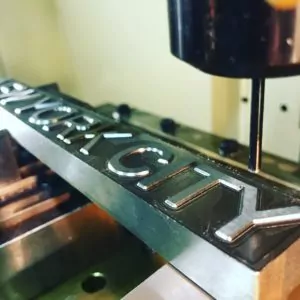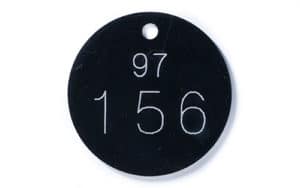When marking metal nameplates with custom information, using the right process can make a world of difference between a great solution and a less successful one.
Stamping and engraving each have their own strengths. The former is incredibly durable while the latter is highly customizable.
In selecting a tag marking process, choosing one that fits your specific application and environment is key.
Stamping
Durability
When durability is the main priority, stamping is hard to beat. It is an incredibly durable process which is relied upon in nearly every type of industrial application and environment.
A custom stamp permanently presses a design into the metal material. As there is no surface level ink to wear or fade, the design is not susceptible to inclement weather.
One major consideration is that the indented design can become concealed by dirt or grime, making the design very difficult to read.
However, with a quick cleaning, the information will be legible again.
Material
Most metal materials can be indented with custom information. Stamps for marking metal are made from a heat treated steel. This offers incredibly striking clarity and resiliency.
The most common materials used for nameplates include:
- Aluminum
- Stainless Steel
- Cold Rolled Steel
- Brass
These materials are durable, and hold the stamped design incredibly well. This ensures that the tag will hold up when exposed to harsh environments.
Stamps
The most important element of the stamping process is of course, the stamp. For custom design marking, a custom stamp must be produced.
This means that every new design requires a new stamp to be produced. Five different tag designs would require five stamps to be made.
With manufacturing, heat treating, additional production time, etc., it can make for an expensive proposition to make multiple stamps.

Tags requiring just a simple number or character set are often able to bypass the cost of a custom stamp by using ones a tag manufacturer already has in inventory.
If you need a high quantity of nameplates marked with a single design, investing in a stamp is much more manageable. The stamp will effectively last forever, so any additional runs of the same design won’t require a new one.
Engraving
Process
The engraving process works much differently than stamping. Engraving uses a tool or laser to cut a design into the material.
This differs from etching as the mark it creates is carved significantly deeper in the metal. This provides considerable improvements to durability as well as legibility. These markings are easy to read in the majority of environments and applications.
Customization
While stamped tags are limited to a single design per stamp, engraved designs can be fully customized.
Each nameplate can feature a unique design. An engraving tool marks each piece uniquely, so there are no restrictions on variable or serialized information.

The tool can cut any type of shape or design into the metal substrate. Some extremely intricate designs may not translate perfectly, but in most cases any design will work.
Drawbacks
Of course, the process is not without its fair share of drawbacks. The biggest being the speed at which metal can be engraved.
With stamping, the entirety of a design can be embedded with a single press. Engraving on the other hand, marks every aspect of the design individually. If a design has five numbers, each number is cut one-by-one.
This makes marking large quantities of nameplates extremely time consuming. Due to the extra processing time, the process can be significantly more expensive as well.
Durability
Similarly to stamping, there is no topical ink for engraving either. Due to this, fading and wearing is not a concern. Engraved designs are considered very durable when it comes to industrial identification.
The deep cuts will take a considerable amount of time before they begin to wear away. Essentially, the metal material itself needs to wear down for the design to be removed.
Industries
Nameplates and placards produced with this process are used by many industries. From simple energy company signage to aircraft placards, there is a wide range of industry usage.
A few examples of common industries:
- Transportation
- Energy
- Defense
- Many More
The ability for more intricate design work lends this process to industries which need to mark specific diagrams or symbols. This can be seen in safety signage or other equipment nameplates.
Material
While stamping can utilize a fairly wide range of materials, engraving is a bit more limited in this regard. Engraving requires a thicker material due to the deep carvings it makes in the metal material.
Materials commonly used for this process include:
- Aluminum
- Brass
- Stainless Steel
- Cold Rolled Steel
These metal material options offer a durable solution for the majority of industrial-type applications and environments.
Wrap-Up
Stamping
Stamping is at the top tier of durable marking solutions. Using a stamp to create a recessed design in the metal material offers superb legibility as well as resiliency.
Custom stamps can be costly, and design options are much more limited than some other processes.
Stamped tags excel best when produced in large production runs of a single design. This keeps the tags very cost effective, and prevents the creation of multiple stamps.
Engraving
Engraved tags offer a balance of durability and customization. The process can uniquely cut many different designs, while providing long lasting identification.
While these nameplates do require a thicker tag to adequately support the deeper impressions, this also helps with the durability
However, engraving is a tedious process, taking a considerable amount of time to mark tags. This makes it less cost effective for high quantity marking.
While it may not be great for large production runs, engraving is suitable for small quantities.
Ultimately, the right marking process is one that is best suited to your specific application.